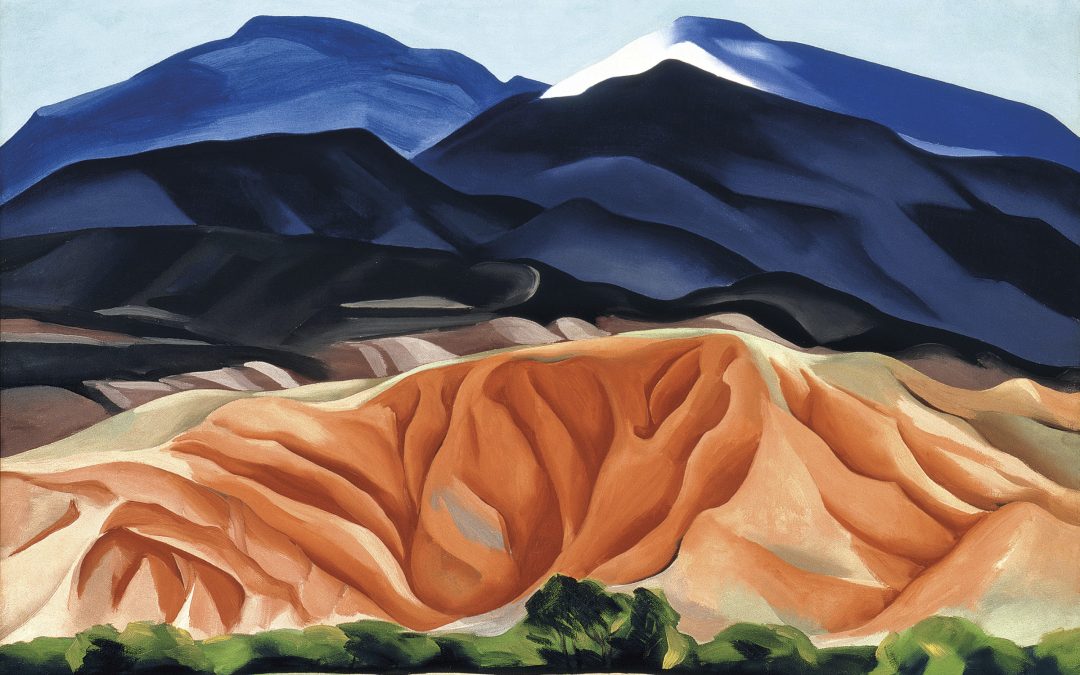During her second summer in New Mexico, Georgia O’Keeffe painted the Black Mesa Landscape while staying at her friend Marie Tudor Garland’s ranch in Alcalde. As is reflective of the majority of her artistic career, O’Keeffe took to painting what was around her. More than simply painting what she sees with the naked eye, however, O’Keeffe also revealed her feelings and personal reaction to her chosen subjects. Black Mesa Landscape, New Mexico/ Out Back of Marie’s II demonstrates O’Keeffe’s deep connection to the New Mexican landscape as well as her awe of nature. Through her use of color, frame, scale, and line, O’Keeffe emphasizes the majesty and power of the desert landscape.
When initially observing the work, the vibrant and contrasting colors both pull the viewer in and push them away. While the coral hills warmly beckon the viewer to come closer, dig deeper, the foreboding blue black of the mountains in the center push the viewer away, as if suppressing some secret. Much of the contrast and conflicting reactions comes from O’Keeffe’s expression of the paradoxical relationship between humans and nature. In one sense, nature calls us in as a place of beauty, greatness, individual journey or spirituality, while at other times nature pushes us out, warning us, reminding us of our place both separate and connected with the great wide world. New Mexico itself is a land of contrasts and extremes, and O’Keeffe’s painting reflects such. At first glance, her use of contrast is most prominent in the light of the red hills and dark of the blue black hills. However, upon closer inspection, contrast is carefully interwoven throughout the entirety of the work. The coral hills, placed just above the deep green of the bottom layer of trees, are accented with sea foam green, making all the more vibrant in the context of the entire painting. Even the deep blue black mountains maintain a degree of contrast against the soft blue of the sky and bright white of the snowy peak.
While the painting and subject matter reflect a traditional landscape, her framing of the subject matter is uniquely modern. Rather than capturing the vast panorama of mountains, hills and cliffs, O’Keeffe isolates her frame to include only a smaller section of the landscape, the layers of mountains. The cropped edges of the mountain, another distinct departure from traditional landscapes, also help drive our focus inward. By narrowing in on the subject so heavily, O’Keeffe draws attention first and foremost to the immense power and glory of the mountains and hills of the desert.
Another way O’Keeffe eschews traditional elements to emphasize the majesty and power of the Black Mesa Landscape is through her use of scale and size. While to an extent O’Keeffe transcribed the contours of the forms as she saw them, she also took liberties to freely change their size and scale against one another (Lynes, 14). In comparing her art to a photograph of the same scene, we see that she enlarges the coral hills in the bottom half of the painting and makes the blue-black hills of the upper half slightly taller than they actually are (14). At the very bottom, O’Keeffe shrinks the trees down to a small blur of green leaves, belittling their importance in comparison to the grand mountains and hills. Similar to her use of frame, O’Keeffe’s decision to enlarge aspects of the landscape emphasizes their deep importance and power over the viewer.
O’Keeffe also dramatizes the landscape through use of different lines. When looking at the painting, it’s evident that no two lines are quite the same. The varied thickness of each line carving the shape of mountains against the sky or ripples within the hills adds a powerful dynamic to the painting. Her use of line also acts to create a unique texture. Among the corral hills, the defined calligraphic lines build an almost flesh-like texture while the softer lines among the blue black hills evoke stormy skies and flowing rivers, reminding the viewer of the diversity and interconnectivity of the vast natural world. Furthermore, the distinct texture also acts as a reminder of the paradoxical push and pull of nature. While the distinct the soft curves of the lines in the landscape’s rolling hills soothe our senses with associations of flowing water or folded fabric, they simultaneously carve out the glory and power of the tall hills boldly placed against a flat blue sky.
O’Keeffe’s juxtaposition of opposing characteristics in her oscillation between traditional and modern, soft and bold, and light and dark create a dynamic piece conveying her deep reverence and awe for the mountains of the desert. More than merely capturing the setting, O’Keeffe demonstrates an unabashed love for the environment through her maze of calligraphic lines, vibrant colors juxtaposed against one another and slight abstraction of the subjects with freely scaled elements. Perhaps she was not a romantic, but her keen emotional connection to the desert landscapes shines through in Black Mesa Landscape.


Recent Comments